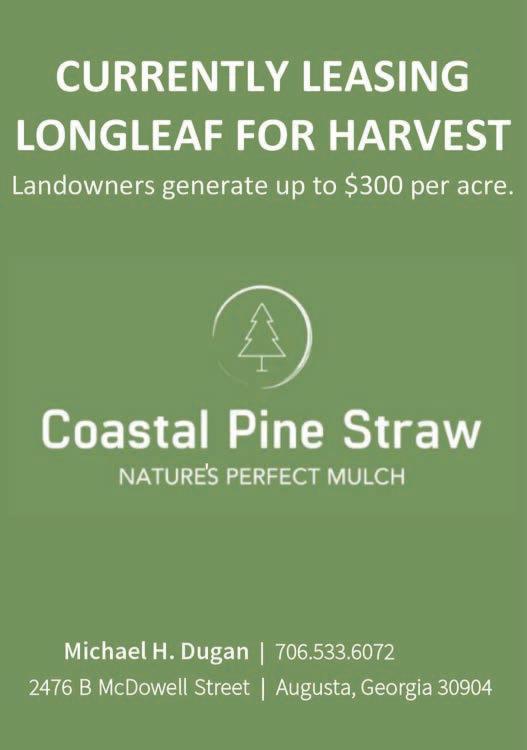
19 minute read
REGIONAL UPDATES
By Chris Erwin, American Forest Foundation, Longleaf Partnership Council Chair
News from the Longleaf Partnership Council
Advertisement
The Longleaf Partnership Council recently hosted its first virtual quarterly meeting in 2021, and there was much to be excited about. We officially welcomed the Heartland Longleaf Implementation Team and its coordinator, Rosalind Rowe of Florida Park Service, to the Initiative. The Heartland LIT is focused on the southern-most portion of the longleaf range in peninsular Florida. We also welcomed Bill Owen, a passionate lover of longleaf and music, from Yale, Virginia, to the Council. Lucas Furman, GIS Coordinator with The Longleaf Alliance, provided an update on a beta version of the Southeast FireMap, which will be published this Spring, offering a snapshot of 26 years of fire history across the longleaf range. We heard from Amy Knight, Senior Botanist with the Florida Natural Areas Inventory, that 4 million acres of longleaf stands, including mixed stands, are now mapped in the Longleaf Ecosystem Occurrence (LEO) Geodatabase. And finally, Sean Sellers, a graduate student at the University of Florida, presented research on ecosystem system services showing longleaf pine ecosystems are more water-use efficient and resilient to drought. Notably, fire-maintained longleaf systems use 15% less water than fire-excluded mixed pine-hardwoods and 30% less water than intensive slash and loblolly plantation. However, long-term studies found that forest structure was a better predictor of water yield rather than species.
Looking ahead, members of the Council are evaluating opportunities to engage and educate the new administration on longleaf forests’ contributions to policy priorities, including climate change and carbon sequestration. Stephanie Hertz, Kyle Jones, and Ryan Bollinger are leading the development of our annual accomplishments report, a valuable resource for key leaders when considering support for longleaf. We will meet again on April 27th and are happy to share any news or concerns you may have. Don’t hesitate to contact me at cerwin@forestfoundation.org.
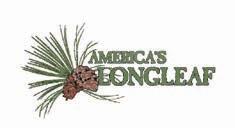

North Carolina Sandhills Conservation Partnership

By Jeff Marcus, The Nature Conservancy
The NC Sandhills Conservation Partnership (NCSCP) was born out of conflict and has become a model of how to do collaborative conservation. A group of forward-thinking individuals from the U.S. Army, U.S. Fish and Wildlife Service, The Nature Conservancy, and others helped to chart a path out of the “woodpecker wars” plaguing Fort Bragg in the 1980s and 1990s. This group took a problem-solving approach to the challenges, creating what would become the Army Compatible Use Buffer (ACUB) program and the Safe Harbor program. They expanded the coalition of stakeholders and formalized the NCSCP in 2000.
The Partnership’s success is attributed to a keen focus on overlapping interests (while minimizing areas of disagreement), a commitment by the participants to address the root causes of problems, and most importantly, the establishment and maintenance of trust. The shared mission of enhancing redcockaded woodpecker populations above the recovery threshold gave the partners a common goal.
The NCSCP invested in developing a conservation plan and mapping conservation priorities. The “Reserve Design” was one of the first landscape-scale priority maps in the region and helped to focus conservation efforts.
The Partnership has facilitated collaboration in a number of areas, chief among them land protection. The land trusts provide landowner relations and nimble action to close on properties, the Army provides significant funding, and state agencies provide long-term management and public access. This synergy attracts additional resources, builds positive relationships in the community, and has enabled the protection of almost 24,000 acres through the ACUB program and approximately 36,000 acres overall since the formation of the Partnership.
Recognizing that no single partner had sufficient resources to manage habitat across the landscape adequately, several state agencies and The Nature Conservancy (TNC) established Memoranda of Understanding that allows partners to share personnel and equipment for controlled burning and other habitat work. The philosophical shift required to make partners willing to commit resources to benefit another partner’s property was only possible after establishing trust, shared values, and a shared vision for the entire landscape. The most prominent example is a TNC burn crew that provides capacity to federal, state, and private partners.


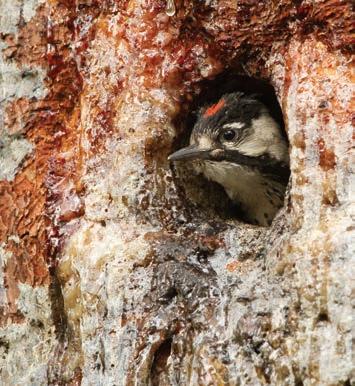

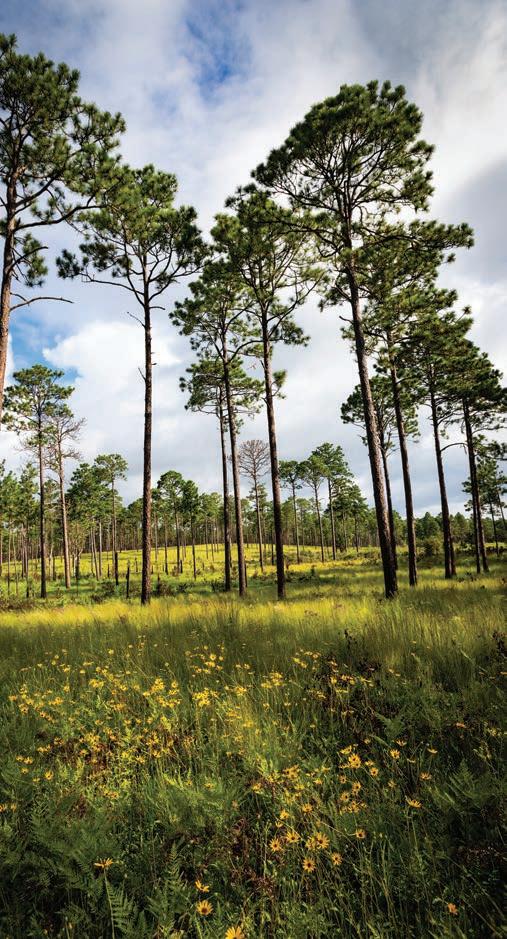
All photos by Brady Beck.
The NCSCP has gotten behind several efforts to support private landowners, notably the Safe Harbor Program, which has enrolled hundreds of landowners totaling >75,000 acres, and the Sandhills Prescribed Burn Association, which is bringing back fire culture with a neighbors-helping-neighbors approach. The Partnership has also attempted to engage local governments through the Fort Bragg Regional Land Use Advisory Commission and the NC Wildlife Resources Commission’s Green Growth Toolbox, with mixed results to date. Increasing buy-in from local governments, developers, and landowners to steer incompatible land uses away from sensitive areas remains one of the biggest and most daunting conservation challenges in the region.
The NCSCP encourages research and surveys to inform our work. The NC Natural Heritage Program, NC Wildlife Resources Commission, NC State University, and Sandhills Ecological Institute are among the key players in collecting onthe-ground species and habitat data. Of particular note is that the NC Sandhills has one of the longest-running studies of demographic data for the red-cockaded woodpecker, spawning dozens of research papers that have informed our basic understanding of the bird’s ecology. The Partnership itself collects data with a dedicated position that conducts surveys on indicator species and habitats to measure progress towards conservation plan goals.
Recognizing an important need and opportunity, the Partnership recently expanded the Local Implementation Team boundary to include a portion of the Uwharrie Mountains in the Piedmont ecoregion immediately west of the Sandhills. The longleaf forests of this region have been significantly reduced and degraded through conversion to loblolly pine plantations and fire suppression, resulting in the extirpation of many longleaf-associated species within the past 40-100 years. However, several climate resilience and other analyses point to the potential of this landscape to support high biodiversity with appropriate management. Inspired by the Uwharrie National Forest’s commitment to restore longleaf, the partners developed a bold plan to bring back longleaf in the region and establish habitat connectors to source populations in the Sandhills.
While much work remains, our shared vision of a future with a viable longleaf ecosystem, and strong working relationships, have allowed the NCSCP to make significant progress and weather the turn-over of key personnel throughout the years.
By Maria Whitehead, Open Space Institute
The Open Space Institute (OSI) announced its latest conservation success along coastal southeastern Georgia in December 2020. OSI secured additional habitat for the threatened gopher tortoise thanks to a discounted sale and transfer by Southern Power (Georgia Power is a charter member of the Fort Stewart/Altamaha LIT). The nearly 2,500-acre Wayne County Conservation property is adjacent to more than 1,600 acres protected by OSI and transferred to the Georgia Department of Natural Resources (DNR) in 2019. Conservation of this property brings Georgia’s public-private Gopher Tortoise Conservation Initiative (GTCI) to more than 80 percent of its goal, to protect the viable gopher tortoise populations required to preclude the species’ listing under the Endangered Species Act. OSI, along with its partners The Nature Hairy rattleweed inflorescence. Endemic to Conservancy and the Conservation Fund, has contributed nearly a third of the longleaf pine ecosystems, hairy rattleweed is total 100,000 acres targeted for conservation by the GTCI. known only in two Georgia counties. Photo by “The Open Space Institute is proud to have protected this amazing property Carol and Hugh Nourse. for Georgia’s state reptile, the gopher tortoise, and the incredible array of other species that call this land home,” said Maria Whitehead, Senior Project Director at OSI. “I thank Southern Power for their incredible generosity in selling this property at a significantly discounted price to make the permanent protection of the land a reality.”
Whitehead also noted that in addition to Southern Power, the project was also made possible through a significant gift by the Knobloch Family Foundation.
In addition to gopher tortoises (Gopherus polyphemus), two other high-priority species are found on the Wayne County property. These include the federally threatened eastern indigo snake (Drymarchon couperi) and the federally endangered hairy rattleweed (Baptisia arachnifera), as well as natural stands of longleaf pine forest with intact groundcover.
White topped pitcher plants at Splinter Hill Bog. Photo by Keith Tassin.

An Alabama Treasure – Splinter Hill Bog Preserve
By Keith Tassin, Alabama Chapter of The Nature Conservancy

Located within the Gulf Coastal Plain Ecosystem Partnership (GCPEP) in northern Baldwin County, about 40 miles north of Mobile, is a truly unique natural treasure known as Splinter Hill Bog. This matrix of longleaf pine-dominated ridges, expansive seepage bogs, and small stream forests located at the beginnings of Dyas Creek is one of the largest tributaries in the headwaters of the Perdido River. Since 2004, The Nature Conservancy and the State of Alabama have been working to protect this biologically rich area that contains some of the largest expanses of white-topped pitcher plant seepage bogs on the Gulf Coast. These conservation efforts have led to the protection of over 3,000 contiguous acres. Over the last fifteen years, the reintroduction of annual to semi-annual prescribed fire has significantly benefited the ecosystems and the wildlife found there. With assistance from GCPEP’s Ecosystem Support Fire Team, over 1,000 acres of fire are implemented annually. A visit to this area will show that the results of these restoration efforts speak for themselves, as the open woodlands are once again home to healthy populations of Bachman’s sparrows, gopher tortoises, and over a dozen species of carnivorous plants. Both the Nature Conservancy and state-owned properties have well-established nature trails that allow visitors to experience the beauty of Splinter Hill Bog. For more information and directions, visit www.nature.org/en-us/get-involved/how-to-help/places-we-protect/splinterhill-bog/ or www.alabamaforeverwild.com/splinter-hill-bog-complex.

By Colette DeGarady, The Nature Conservancy Longleaf Pine Whole System Director
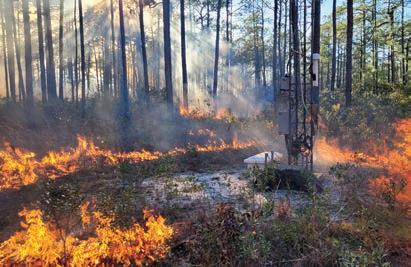
2021 prescribed fire conducted in 90-year-old longleaf stand with carbon sequestration tower. Photo by Jeremy Forsythe.
A Clemson University team is using 120-foot research towers located deep within longleaf forests in coastal South Carolina to study carbon cycling in newly restored and mature longleaf pine stands. In partnership with The Nature Conservancy (TNC), Clemson aims to provide new valuable data and landowner information to contribute to the decade-long effort to restore longleaf across the historic range. This project is supported by a grant from the National Fish and Wildlife Foundation (NFWF) and funding from International Paper.
“To start, it’s really just to answer those basic questions: How does a longleaf pine forest sequester carbon?” says Dr. Thomas O’Halloran, Clemson Assistant Professor and lead on the tower research. The project is being conducted on Hobcaw Barony property — a 16,000-acre research reserve owned by the Belle W. Baruch Foundation and located on the coast near Georgetown, South Carolina, within the Sewee Longleaf Conservation Cooperative (SLCC).
“The Baruch Foundation and TNC are doing a great job managing these forests with prescribed fire,” O’Halloran said. “That has created a wonderful research
opportunity for us right in our backyard.”
O’Halloran already has used his towers to collect about three years of data on carbon sequestration from the longleaf forests; now, following a recent burn in January 2021 on the mature stand, the measurements will factor in the effects of the prescribed burning on carbon sequestration. This new data, in conjunction with existing studies, will be reviewed and used to inform landowners and partners within the SLCC and beyond.
As climate issues are increasingly discussed, and solutions to reduce negative climate impacts are being sought, it’s important to understand what longleaf forests can bring to climate solutions.
A Decade of Collaboration By Susan Griggs, Natural Resources Conservation Service
The Sandhills Longleaf Pine Conservation Partnership (SLPCP) recently marked a decade of collaboration with stakeholders and private landowners toward the singular goal of longleaf conservation. “What is amazing is that nearly all the original partners are still working together to continue the huge impacts we’ve been able to accomplish,” said Partnership Coordinator Charles Babb. “Our success is 100% due to their dedication and commitment to longleaf.” Over the past ten years, partners have contracted with nearly 600 landowners to plant more than 23,000 acres of longleaf. Using the Partnership’s spatial inventory data to assess suitable soils, Babb calculated the landscape scale impact of these efforts. “We’ve SLPCP volunteers and Coordinator Charles Babb prepare established longleaf on roughly 8% of suited soils within our to burn a tract with Dan and Olivia Shultz. Photo by boundaries.” Susan Griggs. Additionally, the spatial data tallied approximately 27,000 additional acres of longleaf not planted with cost-share assistance. This means there are plenty of opportunities for management activities such as prescribed burning.
Over the past several years, Babb has worked alongside landowners to help them learn about prescribed burning. Forty-three landowners have taken the Certified Prescribed Fire Manager (CPFM) course, with 20 having completed their five certification burns.
“We probably work with eight to ten new landowners a year to put fire on the ground. Some have gone all the way through the CPFM certification process, but we have others who aren’t ready for that and prefer just to help us on a burn. Either way, the important thing is that they are learning to be active managers of their longleaf.”
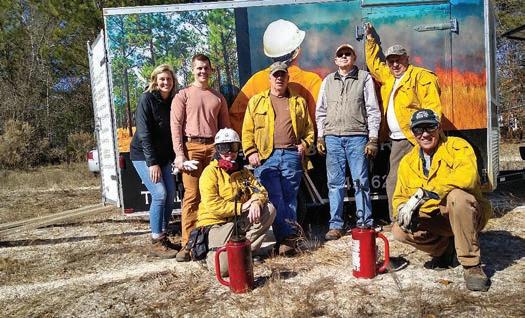
By Jennie Haskell, The Longleaf Alliance
The SoLoACE was awarded a grant from the National Fish and Wildlife Foundation at the end of 2020 for $286,000 to establish 850 acres of longleaf pine and enhance an additional 5,000 acres of habitat with prescribed burning and midstory treatments on public and private lands. The SoLoACE partnerships will work with its land trust partners to protect land with conservation easements and restore two gopher tortoise populations through headstarting. Many SoLoACE partners participated in the Savannah River Clean Water Fund (CWF) Conservation Mapping stakeholder meeting in February to develop highpriority conservation factors and key indicators. The online platform should be available in June 2021. The Savannah River Clean Water Fund is a bistate effort Longleaf regeneration. Photo by Jennie to protect drinking water in the Savannah River watershed; there are many Haskell. overlapping goals between the CWF and the SoLoACE Longleaf Partnership. In November 2020, The Longleaf Alliance assisted with the translocation of three red-cockaded woodpeckers on a property in Aiken County, South Carolina, known as Stable View. These three birds joined the lone RCW that appeared earlier in the year. The equestrian training facility was formerly home to a quail hunting lodge. Efforts to restore the longleaf pine ecosystem include the reintroduction of prescribed fire and midstory mechanical treatment. Across the SoLoACE partnership area, the RCW population continues to expand and flourish. Recently, RCWs repopulated the Long Cane Ranger District of the Sumter National Forest, Aiken State Park, Aiken Gopher Tortoise Heritage Preserve, and Hitchcock Woods. These iconic birds' growing populations speak to the quality of the longleaf ecosystem habitat in Aiken County.
Harvesting native seed. Photo courtesy Texas Native Seeds.

Texas Team Partners with East Texas Natives to Promote Groundcover Restoration
By Tyler Wayland, TLIT Groundcover Working Group Chair
In east Texas, efforts to restore the longleaf pine ecosystem are rapidly increasing. Subsequently, the desire and demand for restoration of the native groundcover component that promotes the iconic diversity and ecosystem services associated with this habitat are also increasing. However, a lack of a reliable native seed supply is one of the largest factors limiting the successful restoration of native grasses and forbs in this system. East Texas Natives (ETN), a regional project of the Texas Native Seeds Program (TNS) operated by the Caesar Kleberg Wildlife Research Institute at Texas A&M University- Kingsville, is a non-profit, science-based research and development project focused on the collection and evaluation of native understory species to select the best performing populations for use in restoration efforts. Our goal is to enable impactful restoration by providing quality ecotypic native seed sources best suited for the region.
ETN has recently joined the TLIT Steering Committee and Groundcover Working Group to expand efforts in groundcover restoration. Together, leveraging regional partnerships, we are working in collaboration to establish viable, dependable commercial seed sources of native Texas understory species that can be widely used for ecosystem restoration projects on the private and public lands of east Texas.
In addition to seed source development, the TLIT Groundcover Working Group is excited to begin work on native groundcover restoration research, effective and efficient planting methodology, and landowner outreach and education efforts. We are also excited to work with landowners and managers to determine current issues and specific needs facing restoration efforts in the region.
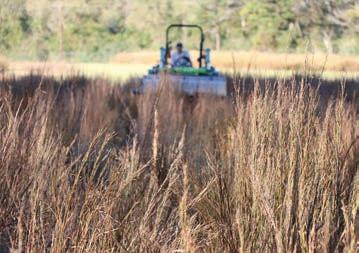
By Brian van Eerden, The Nature Conservancy, and Bill Owen, longleaf landowner
The Virginia Longleaf Cooperators Group (VLCG) held their first virtual annual meeting in February, sharing its partners’ considerable accomplishments in 2020. Acquisitions totaling 1,120 acres expanded the conservation footprint of Big Woods, Nottoway Bogs, Suffolk Scarp, and James River priority areas. The Big Woods area now includes 10,700 protected acres, the first longleaf priority area to eclipse the 10,000-acre mark. A portion of the newly acquired land will be designated as a State Natural Area Preserve by the VA Department of Conservation & Recreation. Partners also protected more than 1,500 acres of riparian forest along the Nottoway River, furthering conservation corridor efforts between longleaf priority areas. Members of the Virginia Longleaf Cooperators Group gathered at Fire crews prescribed burned 1,300 acres in 2020. TNC’s Piney Grove Preserve to observe trial flights of a drone aircraft TNC invested in a drone aircraft for aerial ignition to used to assist aerial ignition operations. Photo by Daniel White. boost fire management capacity, collaborating with partners to integrate this technology into burn operations. More than 3,100 acres are under Natural Resources Conservation Service (NRCS) contracts for prescribed fire in the next three years. Virginia’s new NRCS State Conservationist, Dr. Edwin Martinez, values the importance of landscape-scale, multi-partner initiatives and looks forward to furthering the agency’s support for VLCG.
The VA Department of Forestry (DOF) propagated 125,000 northern range longleaf seedlings at Garland Gray Nursery. A portion was outplanted in the Raccoon Creek Pinelands on land owned by Bill Owen, the newly appointed Longleaf Partnership Council private landowner representative and board member of The Longleaf Alliance; these positions offer Bill opportunities to foster greater awareness about longleaf restoration in its northern range. Seedlings were also planted at South Quay Sandhills Natural Area Preserve, which supports the largest remaining stand of longleaf from Virginia’s original 1.5-million-acre longleaf forest. Funding for these planting projects included support from the Dave Matthews Band and Arbor Day Foundation.
Virginia’s red-cockaded woodpecker population continued to expand, supported by translocations from TNC’s Piney Grove Preserve to Great Dismal Swamp National Wildlife Refuge. The Department of Wildlife Resources’ (DWR) southeastern fox squirrel pilot project includes nest box installation and timber thinning on 450 acres of DWR’s Big Woods Wildlife Management Area (WMA). Field studies at Old Dominion University’s Blackwater Ecologic Preserve, under the direction of Dr. Lytton Musselman, investigate survival of naturally regenerated longleaf seedlings and the use of genetic fingerprinting as a tool for determining the provenance of mature trees found on the preserve. Complementary studies involving native plant reintroductions and herbicide treatments on properties such as Joseph Pine Preserve increase awareness of groundcover restoration opportunities and challenges.
Noteworthy outreach accomplishments include improved public access at Big Woods WMA, expanded educational content through DWR’s “Restore the Wild” program, establishment of a longleaf garden at the Norfolk Botanical Garden, and published articles in several media outlets including a profile article in Blue Ridge Outdoors. VA DOF’s staff reached 139 private landowners across the region.
In June, Virginia lost a forest conservation champion with the passing of Virginia Tree Farm Foundation President John Matel, a private landowner whose enthusiasm and knowledge of longleaf pine and prescribed fire informed and inspired many others across southeast Virginia and beyond. A retired diplomat with the U.S. Department of State, John was thoughtful, generous, and passionate about the importance of forests, conservation, and building connections between people and nature.

By Dan Weber, The Nature Conservancy

Mr. Ben Graham is a third-generation landowner in the piney woods of North Central Louisiana, actively restoring family land to longleaf. He looks after approximately 1000 acres, 400 acres of which he is currently treating. Ben is passionate about the benefits of longleaf and has a keen memory of the historic stands that used to surround the family home. As a longtime collaborator of Longleaf restoration before and after mulching to remove woody fuels in preparation for prescribed fire. Photos by Ben Graham. the West-Central Louisiana Ecosystem Partnership (WLEP), he is always willing to share his story and experience with others. Ben has attended several workshops and a partnership Fire Academy with his eye on the goal of restoring all of his suitable acreage to longleaf.
To alleviate wildfire risk and assist with his restoration path, WLEP partners with Ben to reduce the existing fuel load within his stands using mulching as the primary prescription. With support from the Forest Service and in partnership with The Nature Conservancy, funding was provided to mechanically remove brush and woody vegetation, paving the way for future growing season burns. Removing the dense shrubby areas of pyrogenic species is the first step toward wildfire safety and restoring the historic longleaf ecosystem.
The WLEP is a coalition of stakeholders, including the U.S. Forest Service and U.S. Department of Defense, Natural Resource Conservation Service, state and federal wildlife agencies, conservation NGOs and others, overseeing longleaf and other ecosystem restoration efforts within the Fort Polk/Kisatchie National Forest Significant Geographic Area.

